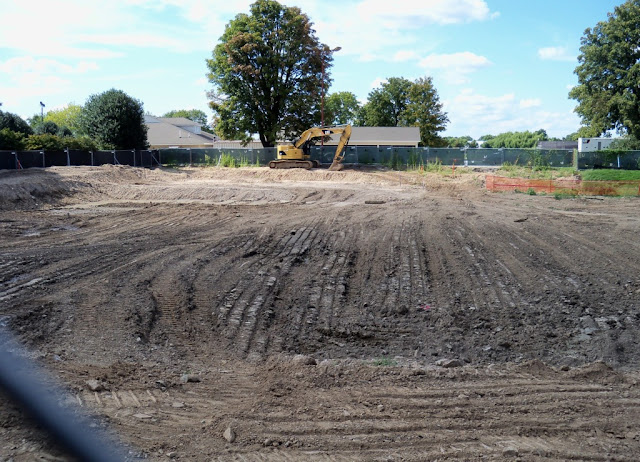Above: Rawlins Park, Washington, DC, between 18th and 19th streets, and across the street from the United Unions Building on New York Avenue, NW (seen here in the background). According to the "New Deal Washington Walking Tour Guide" (Humanities Council of Washington, DC, 2009), "This lovely little oasis, built in 1938, includes a reflecting pool and walkways... [and] is typical of the Works Progress Administration projects that rehabilitated parks throughout the U.S." Some maps actually have Rawlins Park marked between 19th and 20th streets. There is a green area there too, so that may be considered part of the park, but the statue of John A. Rawlins is in the area between 18th and 19th streets shown above. Photo by Brent McKee, September 2018.
Above: The reflecting pools of Rawlins Park are crumbling pretty badly. Rawlins Park actually has history dating back to 1874 (The WPA Guide to Washington, DC, pp. 280-281, 1983 Random House reprint), but according to Washington, DC's Inventory of Historic Sites (2009), a "redesign and reconstruction" occurred between 1935 and 1938, including a new "reflecting pool and landscaping" (p. 134). The work was probably done with WPA labor, as referenced in the previous caption, but rock solid information on this is scarce. Photo by Brent McKee, September 2018.
Above: The water fountain at Rawlins Park. On the day I visited, the whole park smelled like algae (but see power washing a few photos down). Photo by Brent McKee, September 2018.
Above: A closer look at the fountain. I don't know if this is from the WPA's work, but it definitely looks like a very old design / mechanism. Photo by Brent McKee, September 2018.
Above: The statue of John A. Rawlins (1831-1869), a Union General during the Civil War. According to the Wikipedia entry for Rawlins, he served as Secretary of War for President Ulysses S. Grant in 1869, just before his untimely death from tuberculosis. Photo by Brent McKee, September 2018.
Above: Rawlins Park has three levels - the highest along the north border, and then descending down towards the south. I visited the park around 10am and there wasn't a lot of activity, but apparently this is a popular spot during lunch hour. And on the Internet, you can find several spectacular images of Rawlins Park in the Spring, when its Cherry Blossoms are blooming. Photo by Brent McKee, September 2018.
Above: A National Park Service employee, power washing one of the two reflecting pools. The park seems to be fairly well-maintained but, as I noted above, the pools are in desperate need of resurfacing. Unfortunately, due to super-wealthy Americans demanding (and receiving) round after round of tax cuts these past several decades, it probably won't happen anytime soon (for example, as the rich are buying more mansions, yachts, and private islands, the National Park Service has a multi-billion dollar maintenance backlog). Photo by Brent McKee, September 2018.
Above: "Government employees reading papers" at Rawlins Park, June 1942. Photo courtesy of the Library of Congress.
Above: "View of Rawlins Park looking northwest from the roof of the Department of Interior building." The date of this photo is not given, but judging by the vehicles I'd say sometime between 1985 and 1995. Photo courtesy of the Library of Congress.
Above: "Government employees reading papers" at Rawlins Park, June 1942. Photo courtesy of the Library of Congress.
Above: "View of Rawlins Park looking northwest from the roof of the Department of Interior building." The date of this photo is not given, but judging by the vehicles I'd say sometime between 1985 and 1995. Photo courtesy of the Library of Congress.





















































